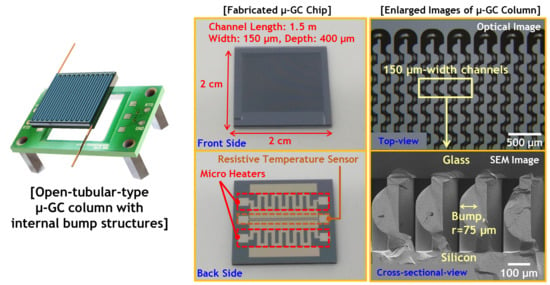Development of Open-Tubular-Type Micro Gas Chromatography Column with Bump Structures
Abstract
:1. Introduction
2. Experimental Section
2.1. Fabrication of Micro-GC Column Module
2.1.1. MEMS Process of Micro-GC Chip
2.1.2. Stationary Phase Coating of Column Channel
2.2. Experimental Setup and Conditions for the Separation Performance
3. Results and Discussion
4. Conclusions
Author Contributions
Funding
Conflicts of Interest
References
- Staples, E.J.; Viswanathan, S. Ultrahigh-speed chromatography and virtual chemical sensors for detecting explosives and chemical warfare agents. IEEE Sens. J. 2005, 5, 622–631. [Google Scholar] [CrossRef]
- Giannoukos, S.; Brkić, B.; Taylor, S.; France, N. Membrane inlet mass spectrometry for homeland security and forensic applications. J. Am. Soc. Mass Spectrom. 2015, 26, 231–239. [Google Scholar] [CrossRef] [PubMed]
- Sottani, C.; Porro, B.; Comelli, M.; Imbriani, M.; Minoia, C. An analysis to study trends in occupational exposure to antineoplastic drugs among health care workers. J. Chromatogr. B 2010, 878, 2593–2605. [Google Scholar] [CrossRef] [PubMed]
- Song, G.; Qin, T.; Liu, H.; Xu, G.-B.; Pan, Y.-Y.; Xiong, F.-X.; Gu, K.-S.; Sun, G.-P.; Chen, Z.-D. Quantitative breath analysis of volatile organic compounds of lung cancer patients. Lung Cancer 2010, 67, 227–231. [Google Scholar] [CrossRef] [PubMed]
- Oliveira, C.R.; Ferreira, A.A.; Oliveira, C.J.F.; Azevedo, D.A.; Santos Neto, E.V.; Aquino Neto, F.R. Biomarkers in crude oil revealed by comprehensive two-dimensional gas chromatography time-of-flight mass spectrometry: Depositional paleoenvironment proxies. Org. Geochem. 2012, 46, 154–164. [Google Scholar] [CrossRef]
- Pietrogrande, M.C.; Zampolli, M.G.; Dondi, F.; Szopa, C.; Sternberg, R.; Buch, A.; Raulin, F. In situ analysis of the Martian soil by gas chromatography: Decoding of complex chromatograms of organic molecules of exobiological interest. J. Chromatogr. A 2005, 1071, 255–261. [Google Scholar] [CrossRef] [PubMed]
- Boots, A.W.; Smolinska, A.; van Berkel, J.J.B.N.; Fijten, R.R.R.; Stobberingh, E.E.; Boumans, M.L.L.; Moonen, E.J.; Wouters, E.F.M.; Dallinga, J.W.; Van Schooten, F.J. Identification of microorganisms based on headspace analysis of volatile organic compounds by gas chromatography–mass spectrometry. J. Breath Res. 2014, 8, 27106. [Google Scholar] [CrossRef]
- Dorman, F.L.; Overton, E.B.; Whiting, J.J.; Cochran, J.W.; Gardea-Torresdey, J. Gas chromatography. Anal. Chem. 2008, 80, 4487–4497. [Google Scholar] [CrossRef]
- Wilson, A.D. Electronic-nose applications in forensic science and for analysis of volatile biomarkers in the human breath. J. Forensic Sci. Criminol. 2014, 1, 1–21. [Google Scholar]
- Qin, Y.; Gianchandani, Y.B. A fully electronic microfabricated gas chromatograph with complementary capacitive detectors for indoor pollutants. Microsystems Nanoeng. 2016, 2, 15049. [Google Scholar] [CrossRef] [Green Version]
- Westman-Brinkmalm, A.; Brinkmalm, G. A mass spectrometer’s building blocks. In Mass Spectrometry; John Wiley & Sons, Inc.: Hoboken, NJ, USA, 2008; pp. 15–87. [Google Scholar]
- Kauffman, G.B. Kirk-Othmer encyclopedia of chemical technology. Am. Sci. 1996, 84, 192–194. [Google Scholar]
- Lorenzelli, L.; Benvenuto, A.; Adami, A.; Guarnieri, V.; Margesin, B.; Mulloni, V.; Vincenzi, D. Development of a gas chromatography silicon-based microsystem in clinical diagnostics. Biosens. Bioelectron. 2005, 20, 1968–1976. [Google Scholar] [CrossRef]
- Akbar, M.; Wang, D.; Goodman, R.; Hoover, A.; Rice, G.; Heflin, J.R.; Agah, M. Improved performance of micro-fabricated preconcentrators using silica nanoparticles as a surface template. J. Chromatogr. A 2013, 1322, 1–7. [Google Scholar] [CrossRef]
- Akbar, M.; Restaino, M.; Agah, M. Chip-scale gas chromatography: From injection through detection. Microsystems Nanoeng. 2015, 1, 15039. [Google Scholar] [CrossRef]
- Serrano, G.; Reidy, S.M.; Zellers, E.T. Assessing the reliability of wall-coated microfabricated gas chromatographic separation columns. Sens. Actuators B 2009, 141, 217–226. [Google Scholar] [CrossRef]
- Spangler, G.E. Relationships for modeling the performance of rectangular gas chromatographic columns. J. Microcolumn Sep. 2001, 13, 285–292. [Google Scholar] [CrossRef]
- Takács, J.M. Contribution to the theory of open-tubular (capillary) columns in gas-liquid chromatography. J. Chromatogr. A 1981, 213, 371–388. [Google Scholar] [CrossRef]
- Terry, S.C.; Jerman, J.H.; Angell, J.B. A gas chromatographic air analyzer fabricated on a silicon wafer. IEEE Trans. Electron Devices 1979, 26, 1880–1886. [Google Scholar] [CrossRef]
- Vial, J.; Thiébaut, D.; Marty, F.; Guibal, P.; Haudebourg, R.; Nachef, K.; Danaie, K.; Bourlon, B. Silica sputtering as a novel collective stationary phase deposition for microelectromechanical system gas chromatography column: Feasibility and first separations. J. Chromatogr. A 2011, 1218, 3262–3266. [Google Scholar] [CrossRef]
- Lu, C.-J.; Steinecker, W.H.; Tian, W.-C.; Oborny, M.C.; Nichols, J.M.; Agah, M.; Potkay, J.A.; Chan, H.K.L.; Driscoll, J.; Sacks, R.D.; et al. First-generation hybrid MEMS gas chromatograph. Lab Chip 2005, 5, 1123. [Google Scholar] [CrossRef]
- Azzouz, I.; Vial, J.; Thiébaut, D.; Haudebourg, R.; Danaie, K.; Sassiat, P.; Breviere, J. Review of stationary phases for microelectromechanical systems in gas chromatography: feasibility and separations. Anal. Bioanal. Chem. 2014, 406, 981–994. [Google Scholar] [CrossRef]
- Lussac, E.; Barattin, R.; Cardinael, P.; Agasse, V. Review on micro-gas analyzer systems: Feasibility, separations and applications. Crit. Rev. Anal. Chem. 2016, 46, 455–468. [Google Scholar] [CrossRef]
- Collin, W.R.; Serrano, G.; Wright, L.K.; Chang, H.; Nuñovero, N.; Zellers, E.T. Microfabricated gas chromatograph for rapid, trace-level determinations of gas-phase explosive marker compounds. Anal. Chem. 2014, 86, 655–663. [Google Scholar] [CrossRef]
- Chen, C.; Tsow, F.; Campbell, K.D.; Iglesias, R.; Forzani, E.; Tao, N. A wireless hybrid chemical sensor for detection of environmental volatile organic compounds. IEEE Sens. J. 2013, 13, 1748–1755. [Google Scholar] [CrossRef] [Green Version]
- Zampolli, S.; Elmi, I.; Mancarella, F.; Betti, P.; Dalcanale, E.; Cardinali, G.C.; Severi, M. Real-time monitoring of sub-ppb concentrations of aromatic volatiles with a MEMS-enabled miniaturized gas-chromatograph. Sens. Actuators B. 2009, 141, 322–328. [Google Scholar] [CrossRef]
- Mohsen, Y.; Lahlou, H.; Sanchez, J.-B.; Berger, F.; Bezverkhyy, I.; Weber, G.; Bellat, J.-P. Development of a micro-analytical prototype for selective trace detection of orthonitrotoluene. Microchem. J. 2014, 114, 48–52. [Google Scholar] [CrossRef]
- Garg, A.; Akbar, M.; Vejerano, E.; Narayanan, S.; Nazhandali, L.; Marr, L.C.; Agah, M. Zebra GC: A mini gas chromatography system for trace-level determination of hazardous air pollutants. Sens. Actuators B 2015, 212, 145–154. [Google Scholar] [CrossRef]
- Azzouz, I.; Bachari, K. MEMS Devices for Miniaturized Gas Chromatography. In MEMS Sensors: Design and Application; IntechOpen: London, UK, 2018; Available online: https://books.google.com.hk/books?hl=zh-TW&lr=&id=B3eQDwAAQBAJ&oi=fnd&pg=PA149&dq=MEMS+Devices+for+Miniaturized+Gas+Chromatography.+MEMS+Sensors:+Design+and+Application,&ots=88KxW4E71O&sig=LHND7WEZiGfiT79x3R0UIa-Aurc&redir_esc=y&hl=zh-CN&sourceid=cndr#v=onepage&q=MEMS%20Devices%20for%20Miniaturized%20Gas%20Chromatography.%20MEMS%20Sensors%3A%20Design%20and%20Application%2C&f=false (accessed on 26 August 2019).[Green Version]
- Grob, R.L.; Barry, E.F. Modern practice of gas chromatography. In Modern Pratice of Gas Chomatography; Grob, R.L., Barry, E.F., Eds.; John Wiley & Sons, Inc.: Hoboken, NJ, USA, 2004. [Google Scholar]
- Li, Y.; Du, X.; Wang, Y.; Tai, H.; Qiu, D.; Lin, Q.; Jiang, Y. Improvement of column efficiency in MEMS-based gas chromatography column. RSC Adv. 2014, 4, 3726–3731. [Google Scholar] [CrossRef]
- Nakai, T.; Nishiyama, S.; Shuzo, M.; Delaunay, J.-J.; Yamada, I. Micro-fabricated semi-packed column for gas chromatography by using functionalized parylene as a stationary phase. J. Micromech. Microeng. 2009, 19, 65032. [Google Scholar] [CrossRef]
- Ali, S.; Ashraf-Khorassani, M.; Taylor, L.T.; Agah, M. MEMS-based semi-packed gas chromatography columns. Sens. Actuators B. 2009, 141, 309–315. [Google Scholar] [CrossRef]
- Finn, A.; Lu, B.; Kirchner, R.; Thrun, X.; Richter, K.; Fischer, W.-J. High aspect ratio pattern collapse of polymeric UV-nano-imprint molds due to cleaning. Microelectron. Eng. 2013, 110, 112–118. [Google Scholar] [CrossRef]
- Li, J.; Yang, S. Fabrication of high-aspect-ratio (up to 10) one-dimensional organic/inorganic hybrid nanogratings via holographic lithography. Microelectron. Eng. 2014, 128, 7–11. [Google Scholar] [CrossRef]
- Dimov, S.; Bennett, R.G.; Córcoles, A.; Levitin, L.V.; Ilic, B.; Verbridge, S.S.; Saunders, J.; Casey, A.; Parpia, J.M. Anodically bonded submicron microfluidic chambers. Rev. Sci. Instrum. 2010, 81, 13907. [Google Scholar] [CrossRef] [Green Version]
- Choi, M.K.; Yoon, H.; Lee, K.; Shin, K. Simple fabrication of asymmetric high-aspect-ratio polymer nanopillars by reusable AAO templates. Langmuir 2011, 27, 2132–2137. [Google Scholar] [CrossRef]
- Frommhold, A.; Robinson, A.P.G.; Tarte, E. High aspect ratio silicon and polyimide nanopillars by combination of nanosphere lithography and intermediate mask pattern transfer. Microelectron. Eng. 2012, 99, 43–49. [Google Scholar] [CrossRef]
- Mao, P.; Han, J. Fabrication and characterization of 20 nm planar nanofluidic channels by glass–glass and glass–silicon bonding. Lab Chip 2005, 5, 837. [Google Scholar] [CrossRef]
- Shih, W.-P.; Hui, C.-Y.; Tien, N.C. Collapse of microchannels during anodic bonding: Theory and experiments. J. Appl. Phys. 2004, 95, 2800–2808. [Google Scholar] [CrossRef]
- Chandra, D.; Yang, S. Stability of high-aspect-ratio micropillar arrays against adhesive and capillary forces. Acc. Chem. Res. 2010, 43, 1080–1091. [Google Scholar] [CrossRef]
- Zhang, Y.; Lo, C.W.; Taylor, J.A.; Yang, S. Replica molding of high-aspect-ratio polymeric nanopillar arrays with high fidelity. Langmuir 2006, 22, 8595–8601. [Google Scholar] [CrossRef]
- Chini, S.F.; Amirfazli, A. Understanding pattern collapse in photolithography process due to capillary forces. Langmuir 2010, 26, 13707–13714. [Google Scholar] [CrossRef]
- Mao, P.; Han, J. Massively-parallel ultra-high-aspect-ratio nanochannels as mesoporous membranes. Lab Chip 2009, 9, 586–591. [Google Scholar] [CrossRef]
- De Mello, A. On-chip chromatography: the last twenty years. Lab Chip 2002, 2, 48N–54N. [Google Scholar] [CrossRef]
- Papendick, H.-D.; Baudisch, J. Tapeworm columns in gas chromatography. J. Chromatogr. A 1976, 122, 443–450. [Google Scholar] [CrossRef]
- Giddings, J.C. Liquid distribution on gas chromatographic support. Relationship to plate height. Anal. Chem. 1962, 34, 458–465. [Google Scholar] [CrossRef]
- Bhushan, A.; Yemane, D.; Overton, E.B.; Goettert, J.; Murphy, M.C. Fabrication and preliminary results for LiGA fabricated nickel micro gas chromatograph columns. J. Microelectromech. Syst. 2007, 16, 383–393. [Google Scholar] [CrossRef]
- Chandra, D.; Yang, S. Capillary-force-induced clustering of micropillar arrays: Is it caused by isolated capillary bridges or by the lateral capillary meniscus interaction force? Langmuir 2009, 25, 10430–10434. [Google Scholar] [CrossRef]
- Liu, H.; Lei, B.; Jiang, W.; Li, Y.; Yin, L.; Chen, B.; Shi, Y. Ultrasound-assisted recovery of free-standing high-aspect-ratio micropillars. RSC Adv. 2016, 6, 16640–16644. [Google Scholar] [CrossRef]
- Tanaka, T.; Morigami, M.; Atoda, N. Mechanism of resist pattern collapse during development process. Jpn. J. Appl. Phys. 1993, 32, 6059–6064. [Google Scholar] [CrossRef]
- Stoykovich, M.P.; Cao, H.B.; Yoshimoto, K.; Ocola, L.E.; Nealey, P.F. Deformation of nanoscopic polymer structures in response to well-defined capillary forces. Adv. Mater. 2003, 15, 1180–1184. [Google Scholar] [CrossRef]
- Reidy, S.; Lambertus, G.; Reece, J.; Sacks, R. High-performance, static-coated silicon microfabricated columns for gas chromatography. Anal. Chem. 2006, 78, 2623–2630. [Google Scholar] [CrossRef]
- Manginell, R.; Bauer, J.; Moorman, M.; Sanchez, L.; Anderson, J.; Whiting, J.; Porter, D.; Copic, D.; Achyuthan, K. A monolithically-integrated μGC chemical sensor system. Sensors 2011, 11, 6517–6532. [Google Scholar] [CrossRef]
- Agilent Technologies. Available online: https://www.agilent.com/en-us/products/gas-chromatography/gc-columns/capillary/gp4053 (accessed on 18 June 2019).
- Agilent Technologies. Available online: https://www.agilent.com/en/products/gas-chromatography/gc-columns/capillary/gs-gaspro (accessed on 18 June 2019).
- Golay, M.J.E. The height equivalent to a theoretical plate of retentionless rectangular tubes. J. Chromatogr. A 1981, 216, 1–8. [Google Scholar] [CrossRef]
- Shakeel, H.; Wang, D.; Heflin, J.R.; Agah, M. Width-modulated microfluidic columns for gas separations. IEEE Sens. J. 2014, 14, 3352–3357. [Google Scholar] [CrossRef]
- Fuller, E.N.; Schettler, P.D.; Giddings, J.C. A new method for prediction of binary gas-phase diffusion coefficients. Ind. Eng. Chem. 1966, 58, 18–27. [Google Scholar] [CrossRef]
- Shakeel, H.; Rice, G.W.; Agah, M. Semipacked columns with atomic layer-deposited alumina as a stationary phase. Sens. Actuators B. 2014, 203, 641–646. [Google Scholar] [CrossRef]
- Li, Y.; Du, X.; Wang, Y.; Tai, H.; Qiu, D.; Lin, Q.; Jiang, Y. High-separation efficiency micro-fabricated multi-capillary gas chromatographic columns for simulants of the nerve agents and blister agents. Nanoscale Res. Lett. 2014, 9, 224. [Google Scholar] [CrossRef]
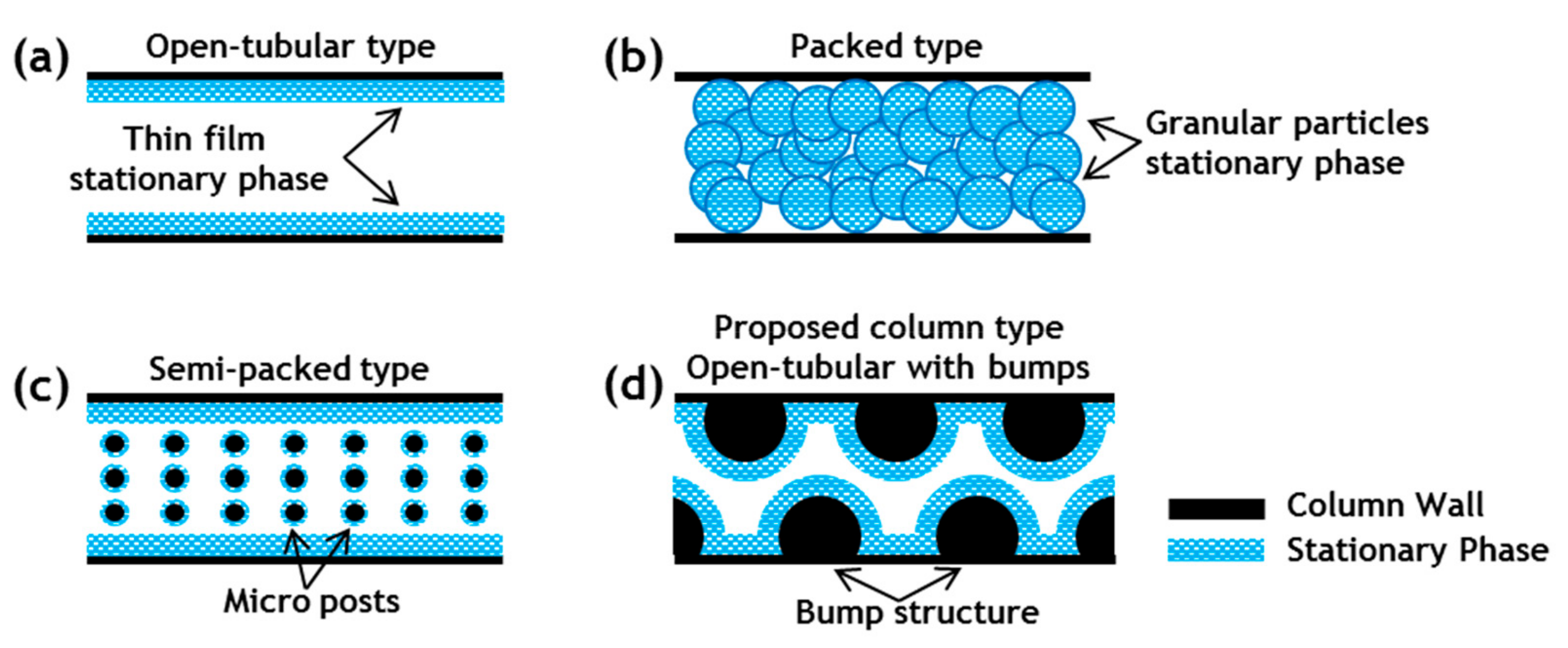
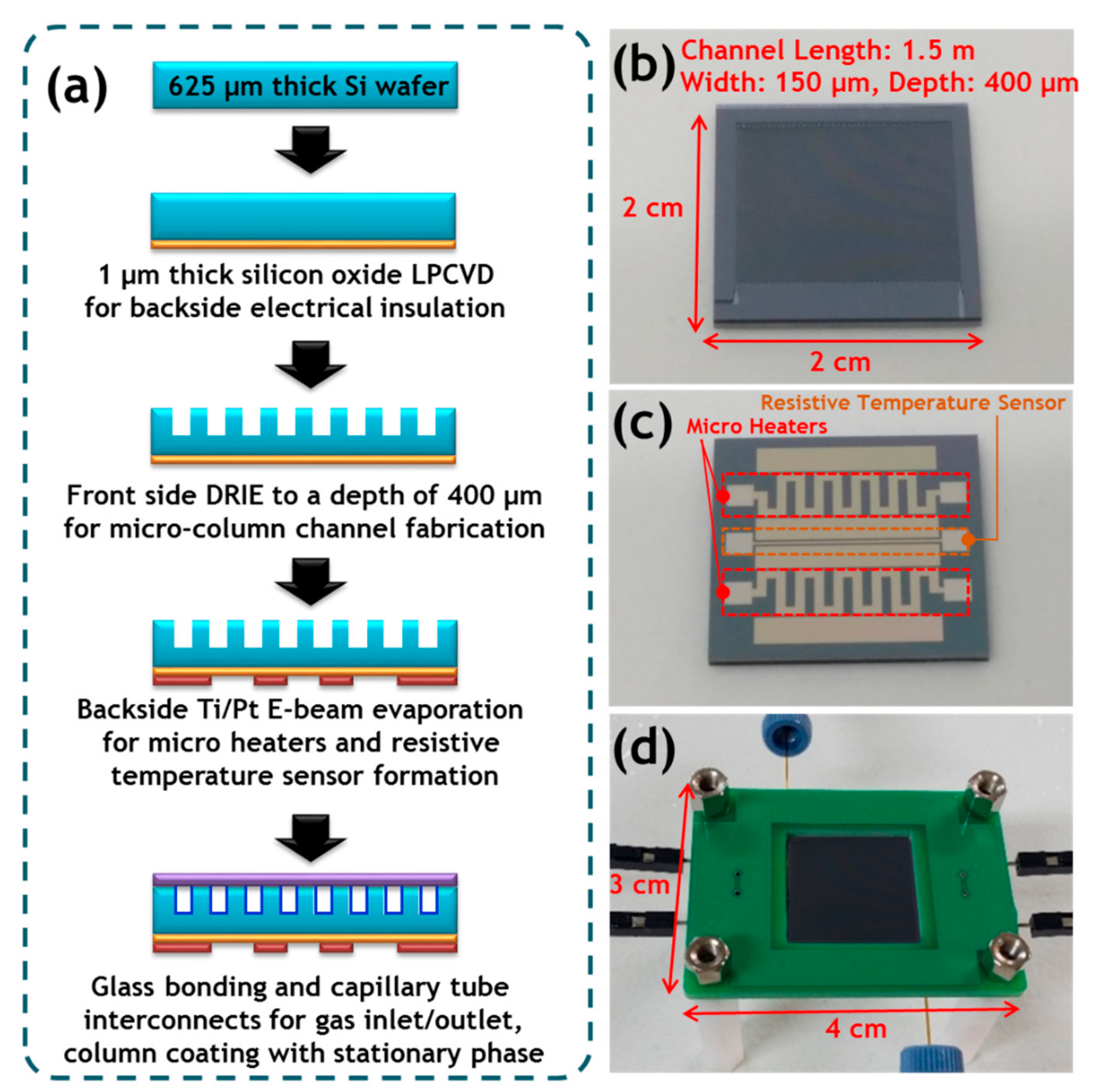
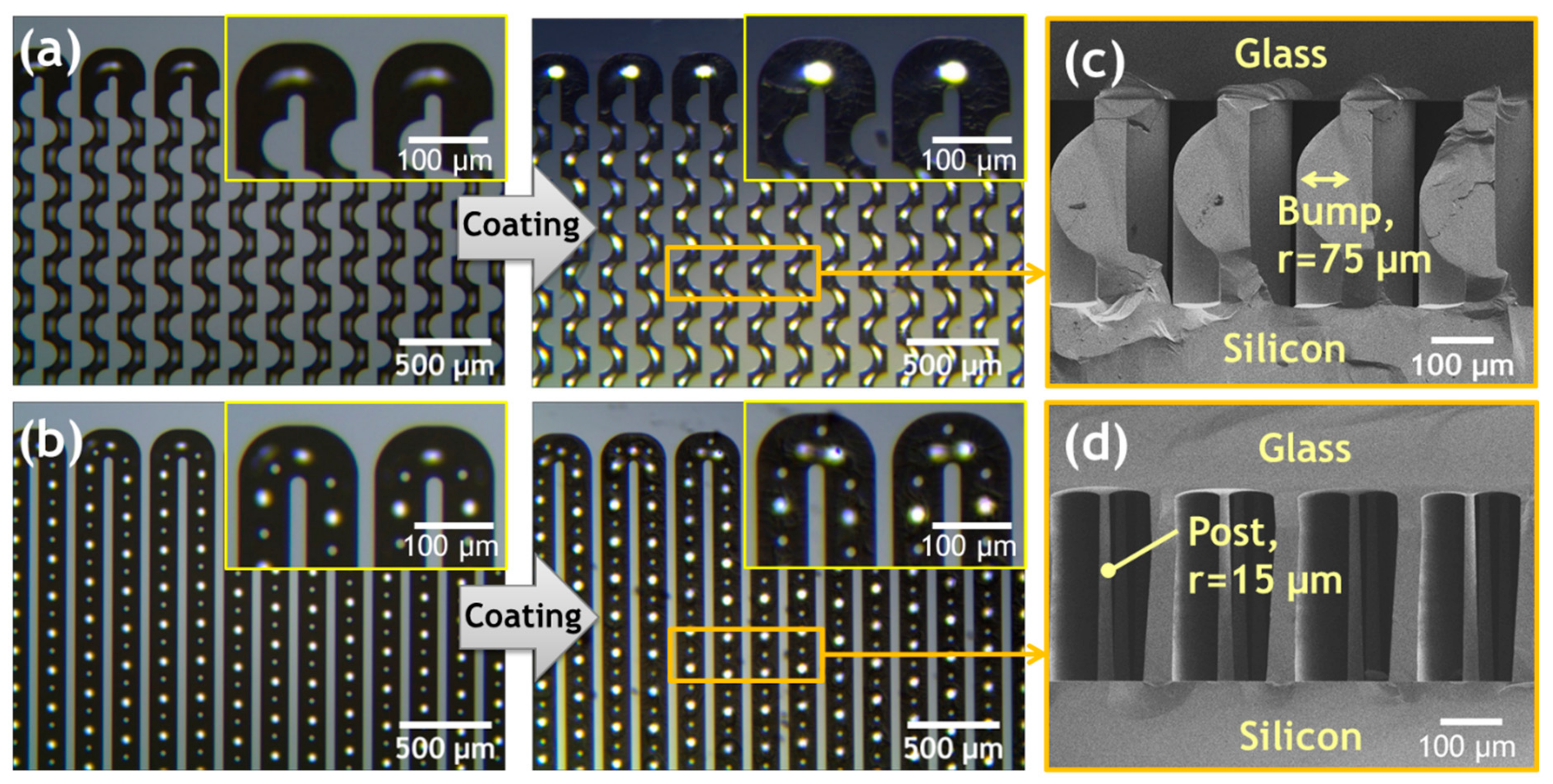
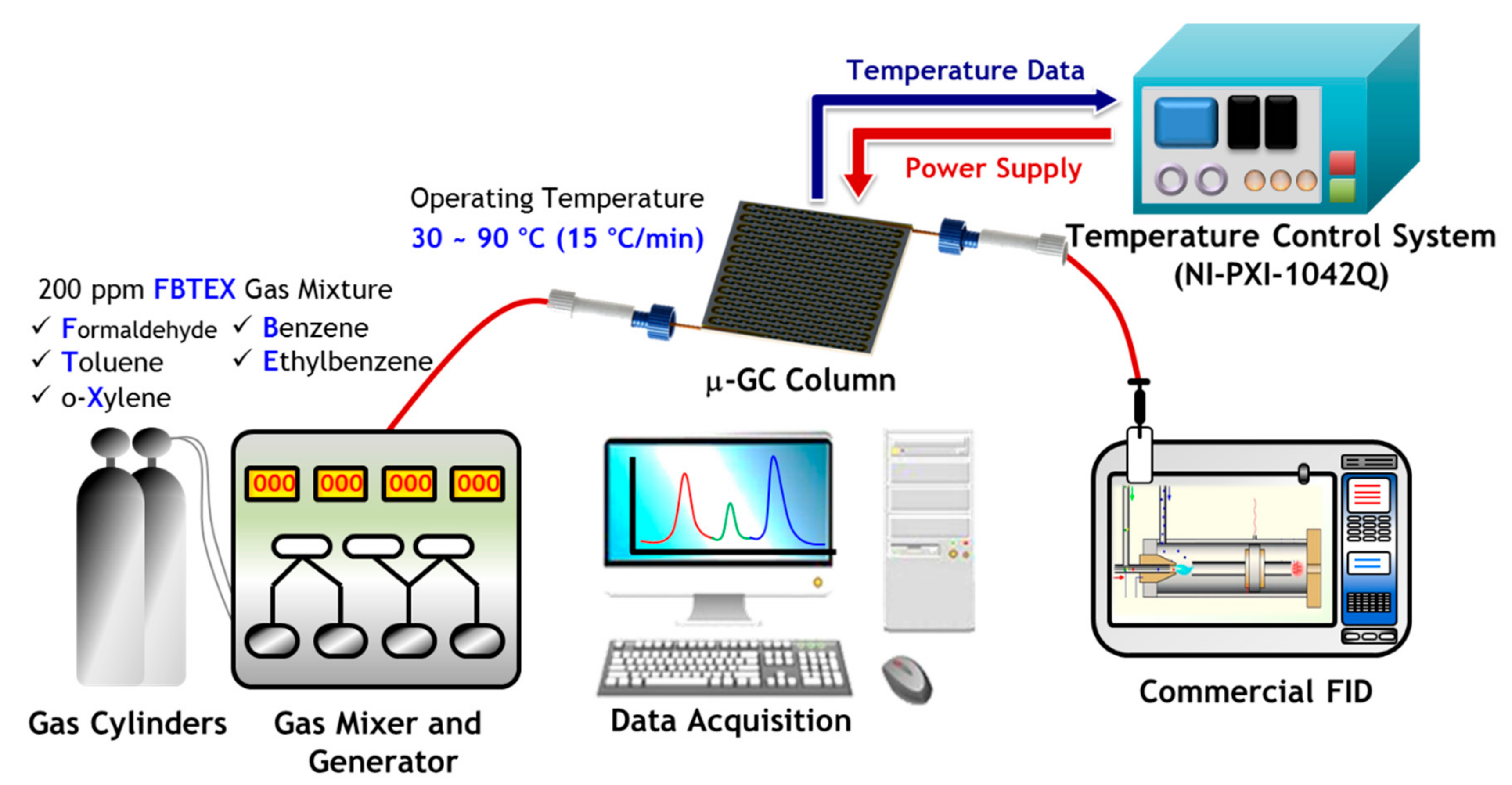
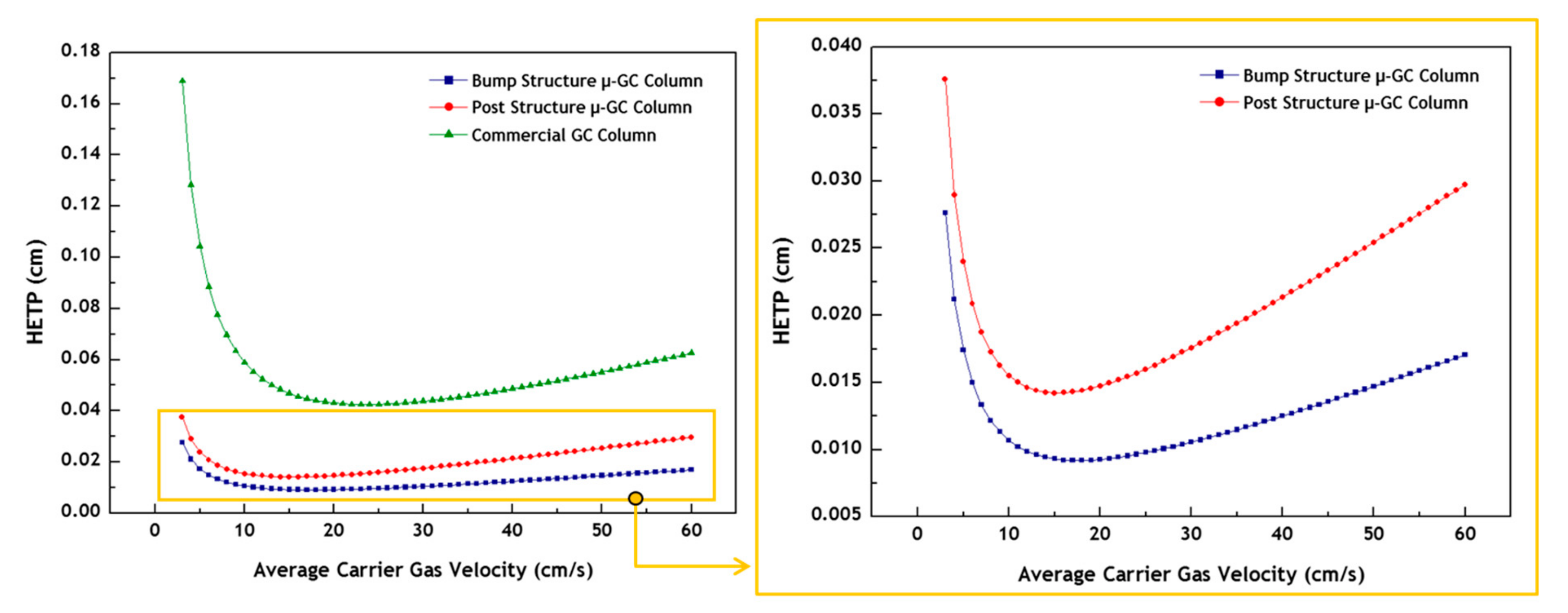
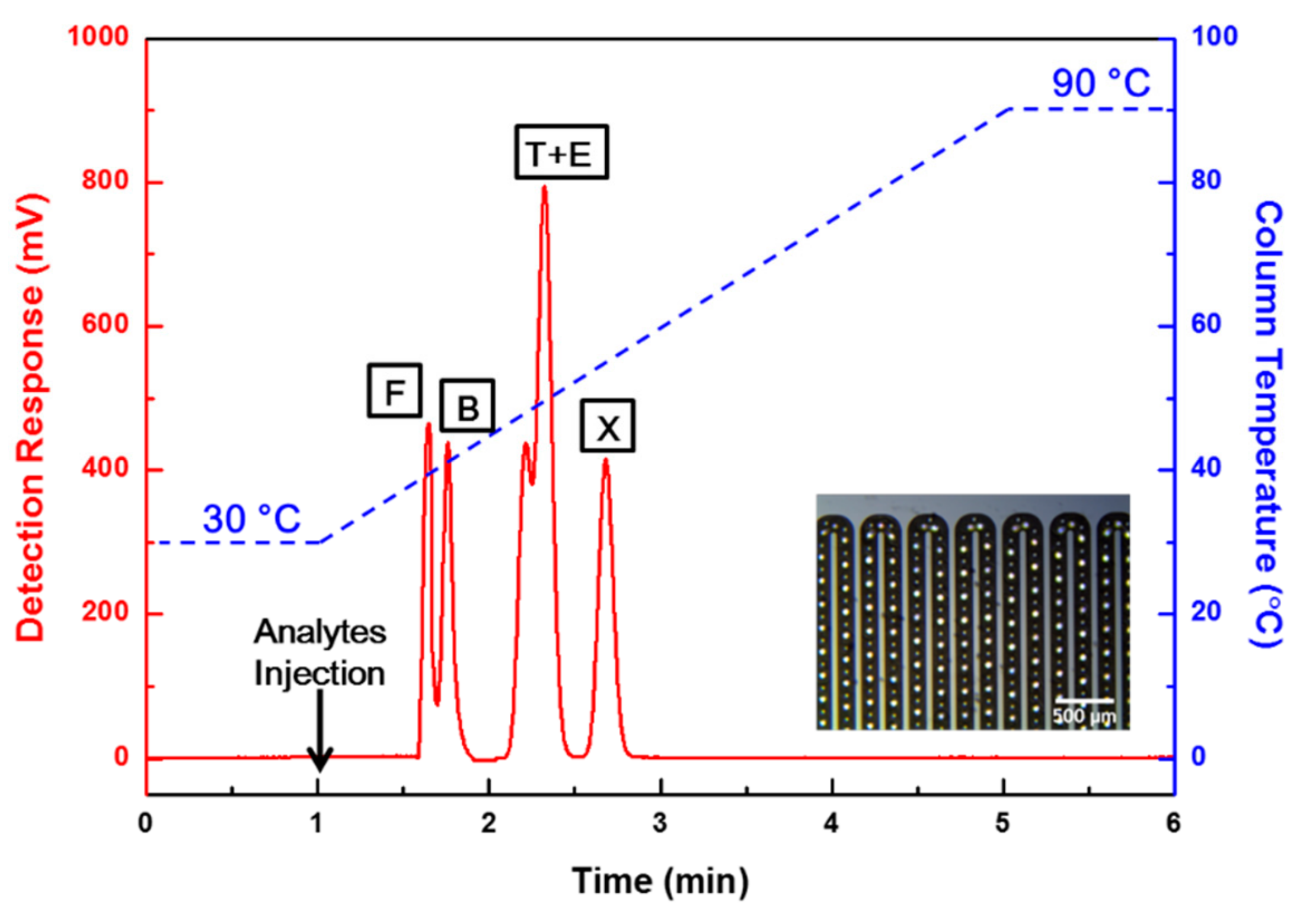

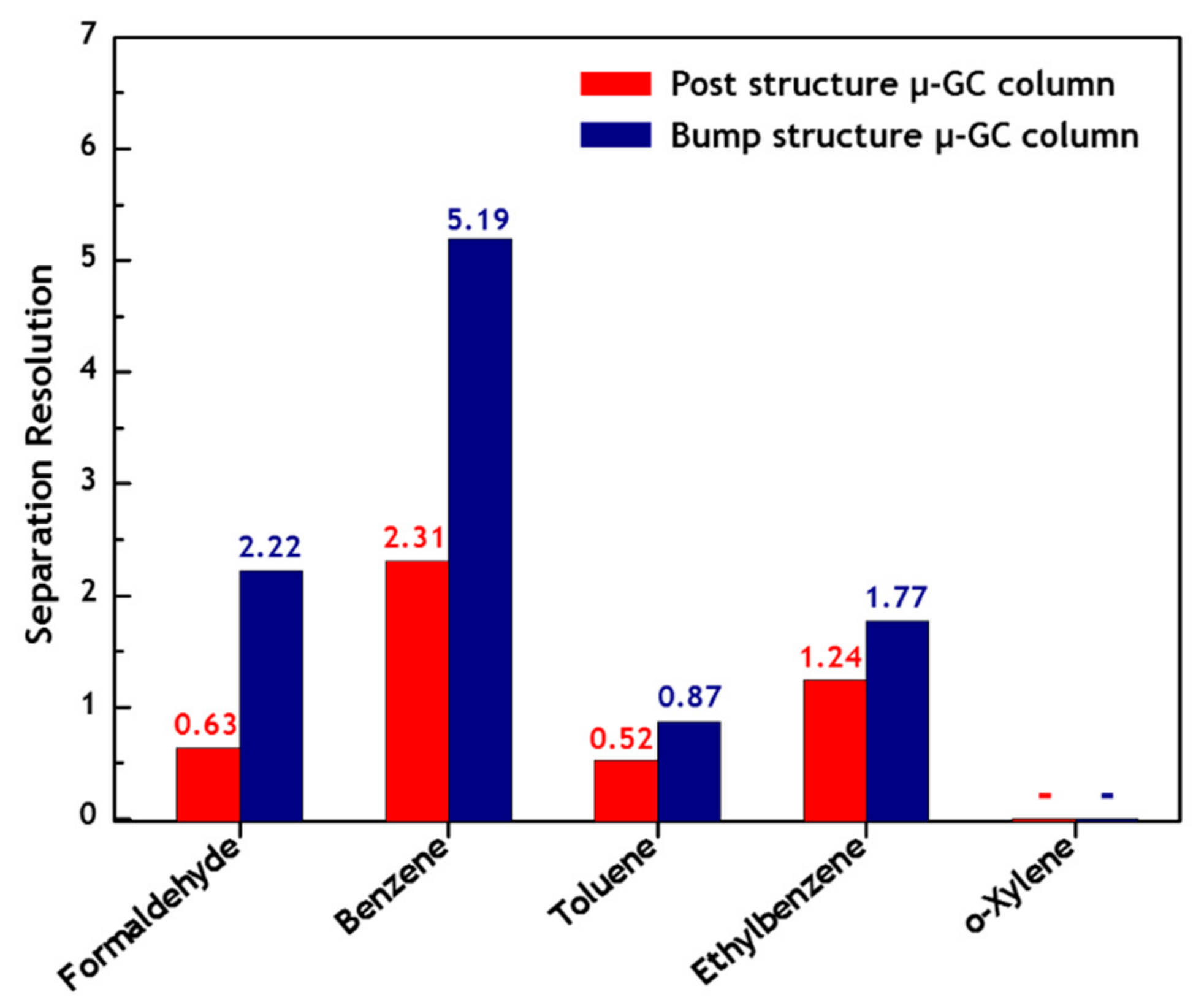
| Analyte | Separation Results for μ-GC Columns | |||
|---|---|---|---|---|
| Post Structure μ-GC Column | Bump Structure μ-GC Column | |||
| Retention Time, tr (min) | Peak Width, wb (min) | Retention Time, tr (min) | Peak Width, wb (min) | |
| Formaldehyde | 0.65 | 0.13 | 0.95 | 0.19 |
| Benzene | 0.76 | 0.22 | 1.36 | 0.18 |
| Toluene | 1.21 | 0.17 | 2.19 | 0.14 |
| Ethylbenzene | 1.32 | 0.25 | 2.32 | 0.16 |
| o-Xylene | 1.68 | 0.33 | 2.63 | 0.19 |
© 2019 by the authors. Licensee MDPI, Basel, Switzerland. This article is an open access article distributed under the terms and conditions of the Creative Commons Attribution (CC BY) license (http://creativecommons.org/licenses/by/4.0/).
Share and Cite
Lee, J.; Lim, S.-H. Development of Open-Tubular-Type Micro Gas Chromatography Column with Bump Structures. Sensors 2019, 19, 3706. https://doi.org/10.3390/s19173706
Lee J, Lim S-H. Development of Open-Tubular-Type Micro Gas Chromatography Column with Bump Structures. Sensors. 2019; 19(17):3706. https://doi.org/10.3390/s19173706
Chicago/Turabian StyleLee, Janghyeon, and Si-Hyung Lim. 2019. "Development of Open-Tubular-Type Micro Gas Chromatography Column with Bump Structures" Sensors 19, no. 17: 3706. https://doi.org/10.3390/s19173706
APA StyleLee, J., & Lim, S.-H. (2019). Development of Open-Tubular-Type Micro Gas Chromatography Column with Bump Structures. Sensors, 19(17), 3706. https://doi.org/10.3390/s19173706





